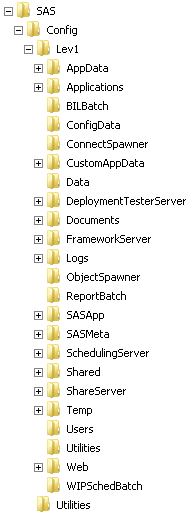Overview of the Configuration Directory Structure
About the Configuration Directory
Every server-tier and middle-tier host has a configuration
directory which is the root of the SAS Intelligence Platform environment.
The structure and contents of the directory vary depending on the
host operating system, which products are installed, and whether the
host machine is a server-tier host or a middle-tier host.
Throughout the SAS Intelligence Platform
administration documentation, the variable SAS-configuration-directory is
used to designate your configuration directory path. The default
paths are as follows:
About the Levn Subdirectory
The
Levn subdirectory
contains configuration information and other files for a particular
installation instance. Lev1 is generally
used for production environments. Additional levels, such as Lev2 and Lev3,
can be used for environments that you install for purposes such as
development and testing. During installation, the SAS Deployment Wizard
enables you to specify the level number.
The contents of the
For more details about the
Levn directory
depend on which components are installed on the machine. Its contents
might include the following:
-
a Web subdirectory for files related to Web applications.
Levn directory, see Contents of the Levn Subdirectory.About the Application Server Subdirectory
On machines where components of a SAS Application Server
are installed, the
Levn directory
contains an application server subdirectory. A SAS Application Server
is a logical entity that contains specific servers (for example, a
SAS Workspace Server and a SAS Stored Process Server) that execute
SAS code. Application server subdirectories are named as follows:
The application server
subdirectory contains the following items:
-
a subdirectory for each component of the application server, including the workspace server, the pooled workspace server, the OLAP server, the stored process server, the SAS/CONNECT server, batch servers, and grid servers (if applicable). Each of these subdirectories contains the server's start-up scripts, configuration files, logconfig.xml files to configure logging, and
Logsdirectories to store log files.
For more details about
this subdirectory, see Contents of the Application Server Subdirectory (SASApp or SASMain). For information about the server
configuration files that are contained in this subdirectory, see Configuration Files for Components of SAS Application Servers.
About the SASMeta Subdirectory
On the machines where the metadata
server is installed, the
Levn directory
includes a subdirectory for the metadata server's files. SASMeta is
the name that the SAS Deployment Wizard assigns to the metadata server
context and, in turn, to this directory.
The
For more information about the metadata server configuration
files, see Configuration Files for the Metadata Server. For a complete list of the contents of the MetadataServer
subdirectory, see Contents of the Metadata Server Subdirectory (SASMeta).
SASMeta directory
contains the following items:
-
-
a script to back up the metadata server (for details, see SAS Metadata Server Backup Tasks).
-
CAUTION:The MetadataRepositories and rposmgr directories contain data sets that are critical to the operation of your system.
-
Back up the contents of these directories regularly, as described in Best Practices for Backing Up and Restoring Your SAS Content.
About the Web Subdirectory
On middle-tier machines (that
is, machines with installed Web components), the
Lev1 directory
contains a subdirectory called Web.
For details, see Contents of the Web Subdirectory. For information about administering middle-tier applications
and components, see the SAS Intelligence Platform: Web Application Administration Guide and the SAS Intelligence Platform: Middle-Tier Administration Guide.
